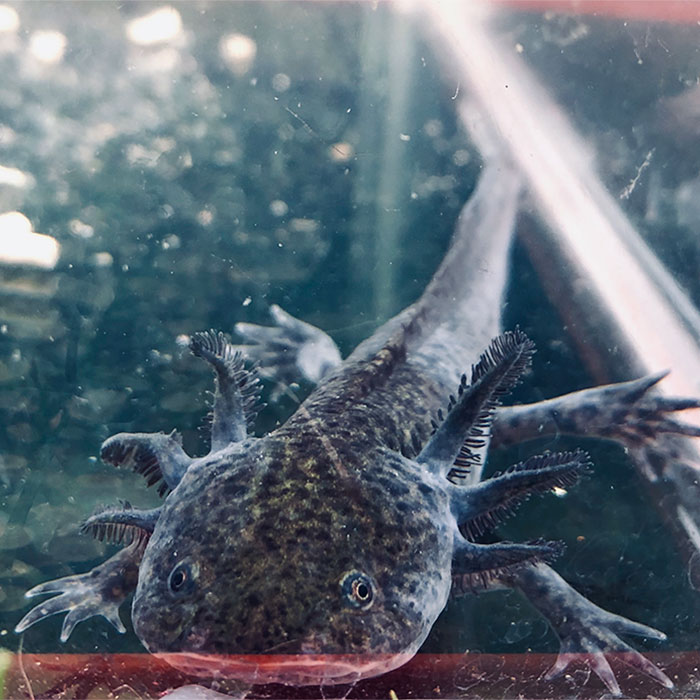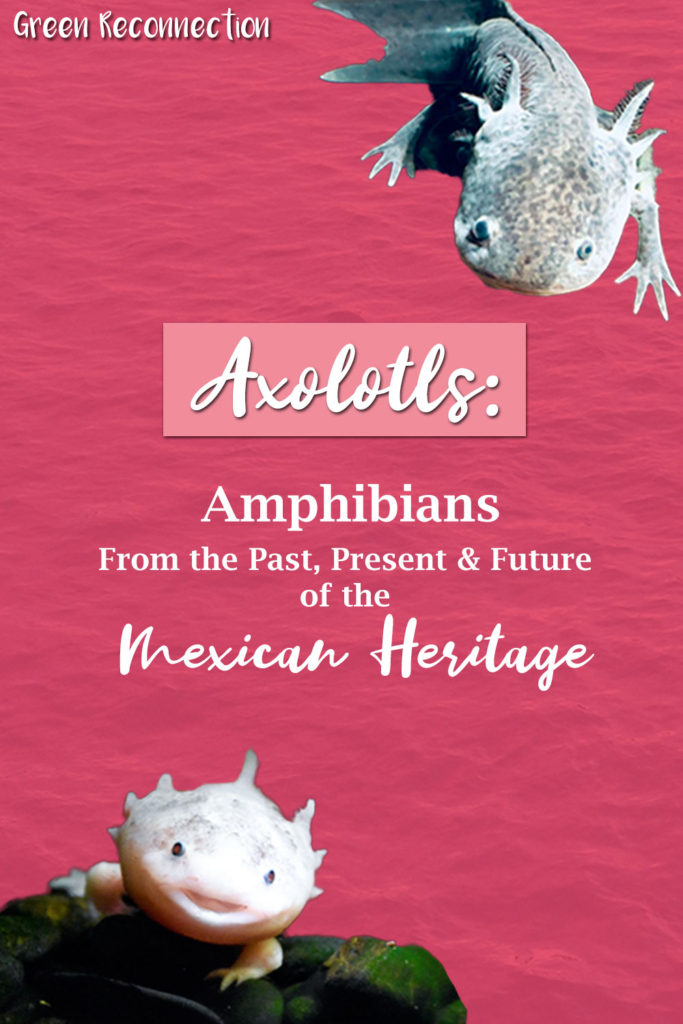Axolotls have been part of Mexican culture through the years and they have gained such popularity, that they have become an emblematic symbol in Mexico City. Lots of people have been inspired by this peculiar amphibian, so it is not a coincidence that we can even find them in paintings or literature. People love axolotls, but they do not know a lot about them and ignore why they are endangered. The purpose of this article is to let people know more about this species and understand its importance by showing facts from Mexican scientists that have studied this emblematic amphibian.
Guest Author: Melisa Enríquez Betancourt

Green Reconnection publishes pieces by outside contributors on the Green Voices page. These publications and their opinions don’t necessarily reflect our own. If you want to be a contributor, you can apply on the Green Voices page.
Who are the axolotls?
“… looking like a small lizard about six inches long, ending in a fish’s tail of extraordinary delicacy, the most sensitive part of our body. Along the back ran a transparent fin which joined with the tail, but what obsessed me was the feet, of the slenderest nicety, ending in tiny fingers with minutely human nails. And then I discovered its eyes, its face. Inexpressive features, with no other trait save the eyes, two orifices, like brooches, wholly of transparent gold, lacking any life but looking, letting themselves be penetrated by my look, which seemed to travel past the golden level and lose itself in a diaphanous interior mystery…”
– Axolotl: Julio Cortázar
Axolotls belong to the family of salamanders, though many people tend to confuse them with tadpoles. The difference between a salamander and a tadpole is that the salamander develops a tail, and the tadpole does not. But the most remarkable difference between a tadpole and an axolotl is that axolotls do not undergo metamorphosis. Axolotls preserve features from their larval stage all through the rest of their lives, and this attribute is called “neoteny”. So it is true that these amphibians have one of the most desirable features for all human beings: “being eternally young”. Apart from this beautiful quality, axolotls have the physiological capacity to regenerate their limbs and other tissues in a short period of time (specifically 40 days), which makes them even more attractive for scientists to do lots of biological studies.
Referring to the axolotl’s diet, it consists of worms, mollusks, insects, and fish. However, studies reveal that their primary food today is based on insects, due to the lack of fish they can eat.
Axolotls reach sexual maturity when they are approximately one year old. Generally, females can lay an average of 100 to 600 eggs in every oviposition, which reveals the great capacity of reproduction of this amphibian. Consequently, breeding axolotls in captivity results in great success to increase the number of axolotls in their natural habitat.
As it is known, the axolotl’s endemic habitat is “Lago de Xochimilco” in Mexico City, but it is also affirmed that these amphibians have lived in “Lago de Chalco” (also in Mexico City) in a minor proportion. As years have gone by, the axolotl’s population has decreased importantly in these places, and that is why it has become so relevant to undertake actions to preserve this amphibian.
Why have axolotls disappeared from their natural habitat?

Since axolotls’ population has decreased significantly in the last decades, worrying scientists so much that they have been trying to figure out the main factors that have contributed to affect this endemic species. The first and most predictable reason is pollution. Certainly, the presence of inorganic and organic contaminants is one of the main factors that affect axolotls’ wellness. According to researchers, the organic contaminants consist of high levels of different genders of bacteria in Lago de Xochimilco, provoking several illnesses in axolotls. Inorganic contaminants are mainly referred to the high concentrations of ammonia nitrogen that decreasing the water´s quality, risking the axolotl´s survival.
Secondly, the introduction of exotic species has provoked a considerable imbalance in the axolotls’ population. Mainly, the three species that have been incorporated are carp, tilapia, and bass. Carp is the fish that predates young axolotls, and decreases the number of plants at the bottom of the lake, where axolotls live and reproduce; tilapia is the fish that predates the axolotl’s larva, and bass is a fish that also predates young axolotls. So, even though a female axolotl can lay a huge number of eggs (100-600), most of these eggs are eaten by these fish. Axolotls are not the only ones that have been threatened by the invasive species. There are other fish populations that have decreased importantly and the impact is seen in the lack of fish for axolotls to predate. Moreover, there are invasive plants that have affected the axolotl’s ecosystem; the introduction of water lily produces a decrement of water and oxygen, because of the effect of evapotranspiration during photosynthesis. Therefore, less water impedes axolotls to live in the lake.
Throughout the years, there have been new regulations that prohibit clandestine fishing of axolotls. Nevertheless, there are people who continue trapping this amphibian. In Mexico, there are several places that traffic these animals illegally these animals. For example, people have used them to heal certain diseases, but this practice is just common between old people with ancient traditions. In addition, it is also very common to find people who sell axolotls as pets at different markets. These axolotls are sold at a higher price, due to the fact that they come from their natural habitat.
As many other species, axolotls are very useful to carry out research about neurons and the elaboration of antibiotics. Some scientists have obtained axolotls from people who live in Xochimilco, in order to carry out their research in an illicit way. And as illicit research continues, the black market persists internationally.
Last but not least, axolotls are also used to study their regeneration capacity. As mentioned before, axolotls have the quality to regenerate their limbs and other tissues perfectly, which makes them so attractive to study to find alternatives for healing human injuries and diseases in the future.
Which are the alternatives taken to preserve this Mexican amphibian?

Scientists have focused their attention on trying to reintroduce axolotls to their natural habitat, by breeding them in captivity; but this alternative has not been successful. Researchers believe that axolotls’ reintroduction may not assure their survival in their ecosystem, and if they were to survive, they would possibly affect the axolotls that already live in the lake. The reintroduced axolotls have the same genetics, so theoretically this could cause the reduction of genetic variability and provoke the complete disappearance of natural axolotls eventually. However, researchers continue studying the conditions of the axolotl’s habitat and the possibility to reincorporate them.
In addition to the chronic environmental problems, there are different theories explaining why there are fewer axolotls in their natural habitat.
Making people conscious of the axolotls’ importance is an alternative, but it will never be sufficiently strong if we continue perceiving them as completely different beings from us. Like many other species of the animal kingdom, axolotls have been used to satisfy our needs for years, and that has caused meaningful damage to nature. Unfortunately, we are now seeing the real consequences that overexploitation has caused to tons of species that live on our planet, and each time it is harder to recover from the damage every time. So, do we have to wait to see Earth in ruins to start valuing and caring about the rest of the living creatures that belong to the planet? I do not think so; that is why it is so important to know about the species that surround us, to understand their relevance on Earth and also in our culture. Those are the reasons why I decided to talk about axolotls, this Mexican amphibian that has been so important for centuries, and that now is harder to find in Lago de Xochimilco.
Axolotls are part of Mexican history; even the Aztec culture associated them with deities. Today, they are part of a huge conservation project to avoid their extinction; and in the future, they could be an alternative to save humans. Giving axolotls another chance to live, gives the rest of living beings the chance to coexist.
Let us know in the comments if you enjoyed the article and if you have any questions for Melisa. You can also find us on Instagram or Facebook. If you want to receive special discounts, information, and news, you can join our community here.
Save for later!

Bibliography
– Aguilar Moreno, Rogelio, & Rogelio Aguilar Aguilar. “The Mythical Monster Of The Lake: The Conservation Of The Axolotl In Xochimilco”. Revista Digital Universitaria, vol 20, no. 1, 2019. Universidad Nacional Autonoma De Mexico, doi:10.22201/codeic.16076079e.2019.v20n1.a1.
– Zambrano González, L., Reynoso, V. H. y G. Herrera. 2003. Abundancia y estructura poblacional del axolotl (Ambystoma mexicanum) en los sistemas dulceacuícolas de Xochimilco y Chalco. Universidad Nacional Autónoma de México. Instituto de Biología. Informe final SNIBCONABIO proyecto No. AS004. México D. F.
– Denys González Cordova, Julio César Romero Salvador. “Genoma Del Ajolote ¿Y Su Conservación En Xochimilco?”. Ciencia UNAM, 2021
– “Axolote Mexicano”. National Geographic, 2021
– “Ajolote”. National Geographic, 2021





